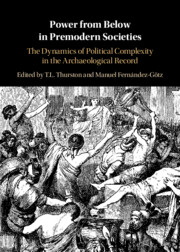 Power from Below in Premodern Societies
Power from Below in Premodern Societies Book contents
- Power from Below in Premodern Societies
- Power from Below in Premodern Societies
- Copyright page
- Contents
- Figures
- Contributors
- Preface
- One Power from Below in the Archaeological Record
- Two Fragmenting Trypillian Megasites
- Three Structure and Agency
- Four Power Requires Others
- Five “And Make Some Other Man Our King”
- Six Societies against the Chief? Re-Examining the Value of “Heterarchy” as a Concept for Studying European Iron Age Societies
- Seven Peasants, Agricultural Intensification, and Collective Action in Premodern States
- Eight The Spread of Scribal Literacy in Han China
- Nine Confronting Leviathan
- Ten The Emergence of Monte Albán
- Eleven Dispersing Power
- Twelve The Perplexing Heterarchical Complexity of New Guinea Fisher-Forager Polities at Contact
- Thirteen Restoring Disorder
- Index
- References
Four - Power Requires Others
“Institutional Realities” and the Significance of Individual Power in Late Prehistoric Europe
Published online by Cambridge University Press: 08 October 2021
- Power from Below in Premodern Societies
- Power from Below in Premodern Societies
- Copyright page
- Contents
- Figures
- Contributors
- Preface
- One Power from Below in the Archaeological Record
- Two Fragmenting Trypillian Megasites
- Three Structure and Agency
- Four Power Requires Others
- Five “And Make Some Other Man Our King”
- Six Societies against the Chief? Re-Examining the Value of “Heterarchy” as a Concept for Studying European Iron Age Societies
- Seven Peasants, Agricultural Intensification, and Collective Action in Premodern States
- Eight The Spread of Scribal Literacy in Han China
- Nine Confronting Leviathan
- Ten The Emergence of Monte Albán
- Eleven Dispersing Power
- Twelve The Perplexing Heterarchical Complexity of New Guinea Fisher-Forager Polities at Contact
- Thirteen Restoring Disorder
- Index
- References
Summary
Dealing with the deep past of Europe in the end always means dealing with ourselves in the present. The study of European prehistory tacitly, but sometimes also explicitly, ends up with statements on the now. Were certain developments in prehistoric society essential to the human condition of the present? Trying to deal with such a question means acknowledging the significance of what Chakrabarty (2009: 212) calls “deep history.” As Morris (2011: 22) puts it, it involves taking every phase in the longue durée seriously and seeing one development as necessarily building on what came before. To a great extent, this is where the relevance of the study of the past for the present lies.
- Type
- Chapter
- Information
- Power from Below in Premodern SocietiesThe Dynamics of Political Complexity in the Archaeological Record, pp. 90 - 105Publisher: Cambridge University PressPrint publication year: 2021


